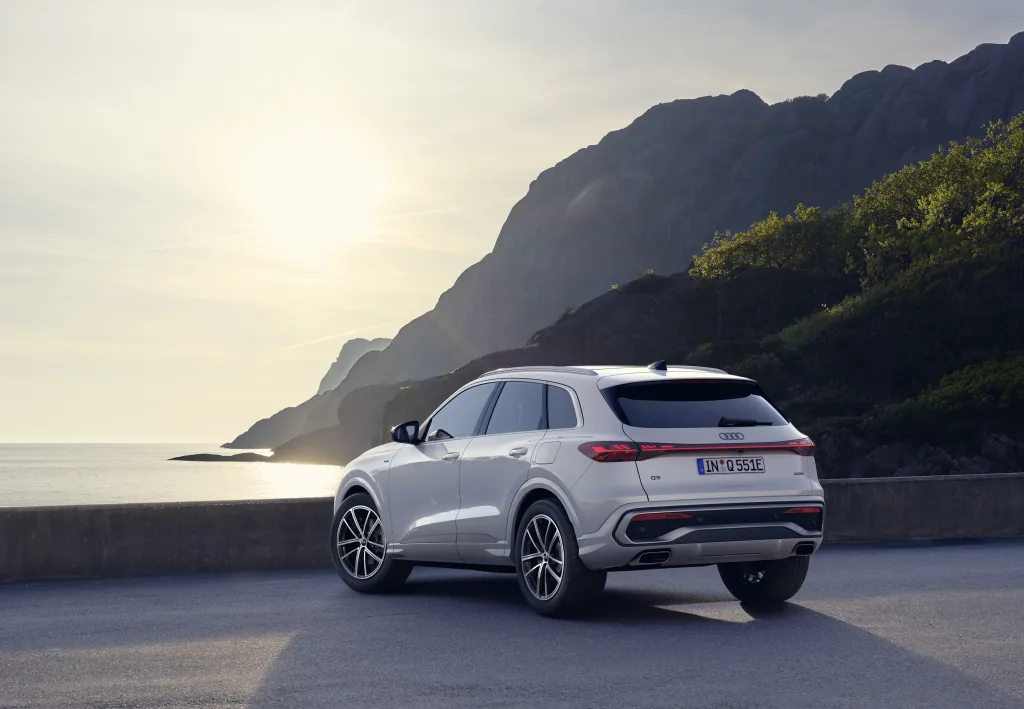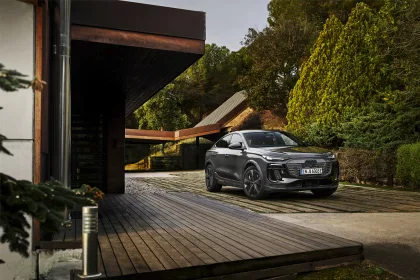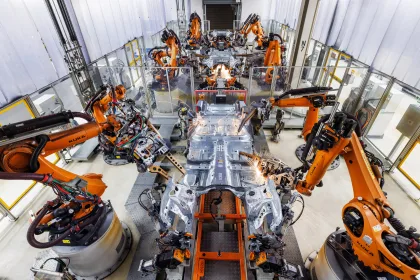- SUV and Sportback as plug-in hybrids with 220 kW or 270 kW system power can travel up to 100 kilometers emission-free
- High-voltage battery with larger capacity, increased recouperation, and intelligent hybrid management ensure efficiency and performance
- Upgraded standard equipment with 3-zone automatic comfort air conditioning; 270 kW version with LED headlights plus and MMI experience plus
Audi is expanding the new Q5 family: in addition to the combustion models with MHEV plus technology, the SUV and Sportback will also be launched as plug-in hybrid models (PHEV). Both the Q5 SUV e-hybrid quattro and Q5 Sportback e-hybrid quattro can be ordered in two power levels: with 220 kW or 270 kW system output. The new generation of high-voltage batteries in the Audi Q5 e-hybrid models has around 45 percent more capacity. As a result, 25.9 kWh (net 20.7 kWh) of power is available for electric driving.
With the new Q5 family, Audi has embarked on the next chapter in the success story of the premium SUV in the mid-size class. The Audi Q5 SUV e-hybrid quattro and Audi Q5 Sportback e-hybrid quattro plug-in hybrid models also bring all the advantages of an SUV and Sportback to the road: space, versatility, suitability for everyday use, quattro drive, plus an even more progressive and dynamic silhouette. A heightened design language, state-of-the-art combustion-engine technology, and the new operating concept are additional outstanding features of the new generation. With a system output of up to 270 kW and an electric range of up to 100 kilometers, the plug-in hybrid models combine a sportily comfortable driving experience with a balanced blend of performance and efficiency.
The new Audi Q5 SUV e-hybrid quattro and the Audi Q5 Sportback e-hybrid quattro are both available in the two power levels 220 kW and 270 kW. The vehicles are driven by a 2.0 TFSI engine with an output of 185 kW and an electric motor. In the 270 kW version the SUV and Sportback can accelerate from 0 to 100 km/h in 5.1 seconds. The 220 kW version13 can do the 0 to 100 km/h sprint in 6.2 seconds. All variants can reach a top speed of 250 km/h (155.3 mph). The electrified dual-clutch transmission in conjunction with the quattro ultra drive ensures a sporty yet comfortable driving experience.
One new development is the high-voltage battery, whose cells in the Q5 e-hybrid are arranged on two levels, one on top of the other. Audi has boosted the battery’s capacity to 25.9 kWh (net 20.7 kWh), roughly 45 percent higher than its predecessor. Maximum AC charging power is 11 kW. If the battery is completely empty, it takes 2.5 hours to charge it to 100 percent.

Two operating modes are available: “EV” and “hybrid.” In EV mode, the SUV and Sportback run exclusively on electric power. When driving in hybrid mode, the hybrid management system maintains a specific charge level as needed in order to save enough electrical energy for later use. In addition to the automatic hybrid mode, the desired charge level can now be individually selected for the first time using a digital slider.
Audi has also significantly increased the regenerative braking performance. The degree of thrust recuperation in EV mode can be adjusted to three different levels using paddles on the steering wheel. The vehicle recovers energy automatically when this function is activated. This is based on route data stored in the navigation system. The Audi Q5 SUV e-hybrid quattro and Audi Q5 Sportback e-hybrid quattro can also recover energy automatically without active route guidance. The hybrid management system of the new models is designed for efficiency, flexibility, and maximum customer comfort and automatically selects the optimal operating strategy.
Both e-hybrid models stand out above all with their upgraded standard equipment. With the 220 kW power option, these include the S sports suspension and 3-zone automatic comfort air conditioning. Those who opt for the 270 kW power version will receive the LED headlights plus and LED rear lights pro as standard. The MMI experience plus infotainment system, which also comes as standard, is equipped with the Audi Application Store, a smartphone interface, and the Audi sound system. The S line interior package with sports seats in a leather/artificial leather combination in black as well as 19-inch ten-arm light-alloy aero wheels and red-painted brake calipers are included as standard. One especially practical feature is the fully adjustable rear seat bench plus. It can be moved lengthwise, and its angle can be adjusted as well.
The Audi Q5 SUV e-hybrid quattro with 220 kW system output is available in Germany starting at 63,400 euros. The price of the Audi Q5 Sportback e-hybrid quattrostarts at 65,900 euros. The SUV version with 270 kW system output starts at 71,800 euros. Prices for the Q5 Sportback e-hybrid quattro with the higher power option start at 74,300 euros. Produced in San José Chiapa in Mexico, the new PHEV models will be available to order in Europe starting in mid-June 2025. The initial launch is planned for the third quarter.
Upgraded standard equipment for SUV and Sportback
Like the combustion-engine models, the Audi Q5 e-hybrid models have also significantly improved key attributes and offer a comfortable feeling of space – something that people notice right from the moment they get into the car.
The fully adjustable rear seat bench plus is part of the standard equipment of the plug-in hybrid models. It can be moved lengthwise and its angle tilted, increasing the trunk volume or comfort for rear passengers as required. At the same time, the rear bench seats three people comfortably. The SUV has a trunk volume of 438 liters (15.5 cu ft). The Sportback offers 433 liters (15.3 cu ft) of storage space. With the rear seats folded down, the transport volume increases to up to 1,358 liters (48 cu ft) in the SUV and 1,300 liters (45.9 cu ft) in the Sportback.

Other practical features include a larger storage compartment under the center armrest compared to the previous model and numerous smaller storage areas for sunglasses, keys, and other everyday items, a cooled inductive charging tray with 15 watts of charging power in the front center console as well as two USB-C ports in the front and two in the rear. Available as an option, the USB ports in the front support charging capacities of up to 60 watts; the rear ports even support charging capacities of up to 100 watts. This means that larger devices such as laptops can be safely powered and charged while driving.
The upgraded standard equipment in the 220 kW power variant includes the S sports suspension and 3-zone automatic comfort air conditioning. Those who opt for the 270 kW variant will receive the LED headlights plus and LED rear lights pro as standard. The MMI experience plus infotainment system is equipped with the Audi Application Store, a smartphone interface, and Audi sound system. The S interior package with sports seats in a leather/artificial leather combination in black is also included as standard, as are 19-inch ten-arm light-alloy aero wheels and red-painted brake calipers.
Intelligent drive management for greater efficiency
The hybrid management system of the new models is designed for efficiency, flexibility, and maximum customer comfort and automatically selects the optimal operating strategy. The electric drive is provided by a permanently excited synchronous motor with a peak output of 105 kW. The electric motor is integrated into the housing of the seven-speed S tronic. The full system torque is available even at close to idle speed – 500 Nm with 270 kW system output and 450 Nm for the 220 kW power variant.
The power electronics (pulse inverter) used in the plug-in hybrid models of the Q5 are a new development. The pulse inverter is smaller, lighter, and more efficient, thus reducing electrical consumption. Consumption in hybrid mode is therefore also lower.

Battery capacity and energy density significantly increased
The heart of the new Q5 plug-in hybrids is the new high-voltage battery (HV battery) at the rear of the vehicle. Audi has boosted its capacity to 25.9 kWh (net 20.7 kWh), roughly 45 percent more than its predecessor. The HV battery is 517 × 880 × 302 millimeters (20.4 × 34.6 × 11.9 in) in size for the best possible integration into the available installation space. The further developed and significantly optimized interaction between the mechanical friction brake and energy recovery via the electric motor has also increased regenerative braking performance.
The battery cells for the Q5 SUV e-hybrid quattro and Q5 Sportback e-hybrid quattro are arranged on two levels due to the available space and are integrated into the rear section of the car. Each prismatic cell stores approximately 46 percent more energy than the cells previously used in high-floor vehicles in the C segment. Each cell has a charge capacity of 70 ampere-hours (Ah). The raw material composition of the 102 cells enables a higher energy density. Six stacks with 17 cells each form a unit and are connected in series.

As far as the arrangement of the battery cells is concerned, Audi is pursuing a new approach with cell-to-pack. In this process, the cells are no longer placed in a battery module but are glued directly into the battery housing. The higher packing density means that the energy content and energy density of the HV system can be increased while taking up less space. Thanks to technical developments in cell chemistry, higher electrical output is available compared to the previous generation, even at a low state of charge and low outside temperatures.
The maximum possible AC charging power has been increased from two-phase 7.4 kW to three-phase 11 kW, depending on the respective infrastructure. With this increase, the HV battery’s zero-to-100-percent charging time has been reduced to just 2.5 hours. A charging cable (mode 3, plug type 2) for convenient charging at home and on the road is included as standard. Audi’s own charging service, Audi charging, provides access to numerous AC charging points in 28 European countries on request.
More energy recovery in overrun and braking mode
Compared to the previous generation of PHEVs, Audi has significantly increased regenerative braking performance. The PHEV model fundamentally tries to drive on electric power for as long as possible and to fully utilize the available battery charge en route to the destination. The phases in which the driver takes their foot off the accelerator pedal are crucial for the efficiency of the plug-in hybrid drive. In such situations, overrun recuperation is controlled via a defined deceleration depending on the selected drive level. Automatic recuperation can also be preset in the MMI in driving levels D and M; the vehicle then varies the recuperation automatically.
The parameters for this are route data stored in the navigation system such as gradients, curve radii, town signs, and speed limits. Another important factor is the traffic ahead. As soon as automatic regenerative braking is selected, predictive signals are fed into the overrun regenerative braking function with the help of Predictive Efficiency Assistant (PEA). The new Q5 e-hybrid can also recover energy automatically without active route guidance.

When the brake pedal is pressed during deceleration, the Q5 SUV e-hybrid quattro and Q5 Sportback e-hybrid quattro can recover up to 88 kW of power and feed it into the HV battery. When operated as a generator, the electric motor accounts for more than 90 percent of all deceleration processes. The integrated brake control system with blending capability (iBRS) ensures pressure-free braking and the best possible energy recovery. The hydraulic wheel brakes are only used for harder braking maneuvers. This has no effect on the braking feel for the driver, as the brake pedal and brake hydraulics are decoupled.
Recuperation level adjustable via steering-wheel paddles
Thanks to the new E3 electronics architecture used in the Premium Platform Combustion (PPC), the degree of thrust recuperation in electric driving mode (EV mode) can be adjusted to three different levels using paddles on the steering wheel, just like in the all-electric models. Electric braking and thus the recuperation level are selected using the left paddle (minus). The right paddle (plus) can be used to reduce the recuperation level. The paddles can thereby be used to set a higher level of deceleration before a turn, for example. At level zero, the plug-in hybrid coasts freely without additional drag torque when the foot is taken off the accelerator pedal. With this setting, energy is only recovered when the brake is applied.
Intelligent operating strategy for maximum efficiency
Two operating modes are available in the new Q5 PHEV models: “EV” and “hybrid.” In EV mode, the PHEV models run exclusively on electric power. The combustion engine is only switched on in the following situations: by deliberately deselecting EV in the switch bar below the panoramic display or via the MMI; in driving program S; via the selected mode of the Audi drive select dynamic handling system; or when starting route guidance with hybrid assist activated. If navigation route guidance is activated, the hybrid assistant takes the route data into account when selecting the drive mode.
The combustion engine also engages during kickdown, and EV mode is deactivated until the kickdown action is over. If none of these situations occur, the new PHEV models use the HV battery in EV mode until it is completely discharged. The digital slider used to control the desired state of charge via the MMI in hybrid mode cannot be operated in EV mode; that is because the battery charge will be fully utilized in electric mode. EV mode enables speeds up to 140 km/h. The PHEV models can be started either in EV mode or in hybrid mode. The mode used last is the default mode for when the vehicle is started next.

When driving in hybrid mode, the hybrid management system maintains a specific charge level as needed in order to save enough electrical energy for later use, for example for electric driving in the city. The Q5 e-hybrid can drive up to 113 km (70.2 mi) on electric power alone according to the WLTP EAER City value.
When it comes to efficiency-optimized consumption, hybrid mode is most efficient for both short and long distances. Depending on the driving situation and the driver’s power needs, the operating strategy decides whether to drive in electric or hybrid mode in order to be as efficient as possible. The PHEV model prefers to drive electrically in urban areas. At higher speeds, the proportion of hybrid driving increases. With active route guidance, the operating strategy takes the planned route into consideration. The operating strategy then automatically selects the best possible energy configuration for the desired route. To achieve the highest efficiency, the vehicle calculates which parts of the route are suitable for electric driving. For example, electric driving is preferable where speeds are likely to be low, such as in urban areas and traffic jams. When the hybrid assistant is activated and route guidance is on, settings such as the desired charge level will be overwritten to ensure an efficient operating strategy.
On top of the automatic hybrid mode, the desired charge level can now be individually set for the first time using a digital slider. Drivers can use it to precisely define how high the charge level of the HV battery should be. The charge level can also be set before your trip, so that there will be enough energy available for electric driving at the destination if so desired, or if there is no charging option there. The desired charge level can be set using a digital slider on a percentage scale. If the target state of charge (SoC) is lower than the current SoC, the battery will be discharged down to the target level.
If the target and current values match, power will mainly come from the combustion engine – in order to maintain the current SoC. If the target SoC is higher than the current SoC, the vehicle will be powered by the combustion engine – in order to recharge the battery. The battery is charged with a view to maximizing efficiency and minimizing environmental impact. This means that the combustion engine only charges the battery at speeds above 65 kilometers per hour (40 mph); at low speeds, the charge level is simply maintained.
This maximizes efficiency and enables partially electric driving in the city or in stop-and-go traffic. The HV battery can be charged in this way up to a 75-percent state of charge. This ensures that the battery is charged with maximum efficiency while driving. To increase the battery’s charge above 75 percent, an external AC charging source is required.















